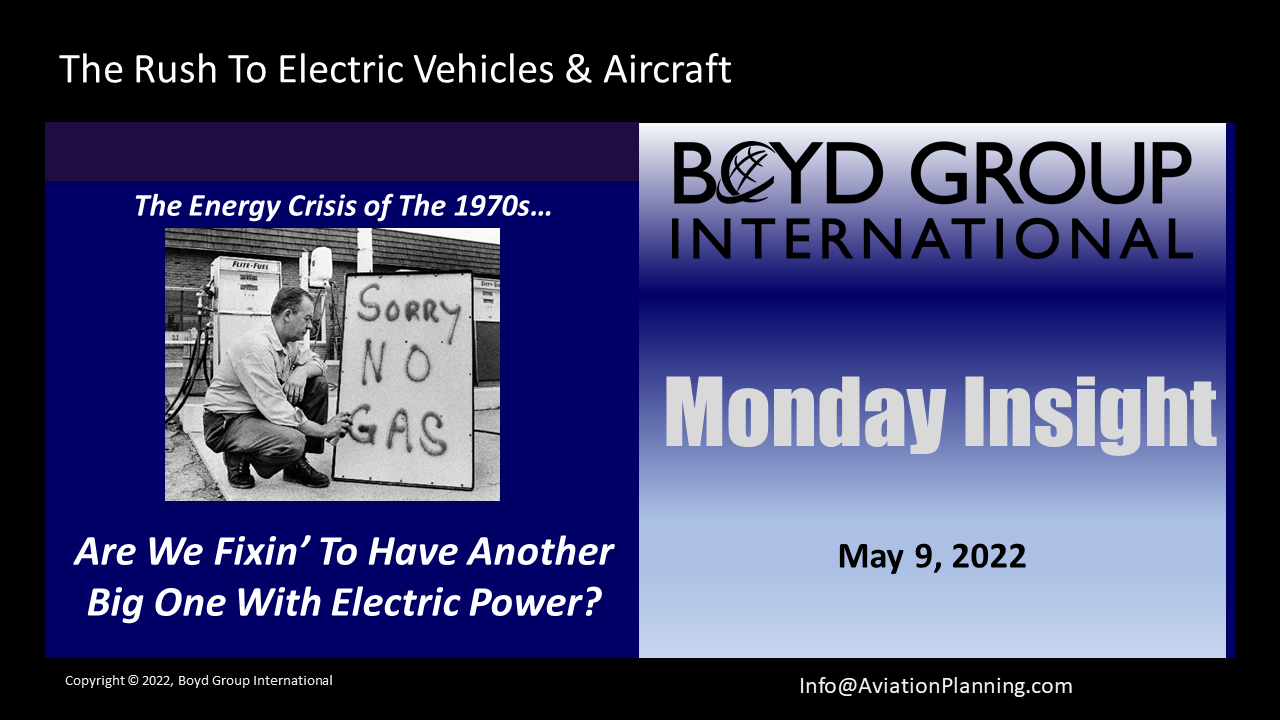Batteries Not Included?
Disclaimer. Gotta be careful with what we say, apparently, now that there’s an official TSA Disinformation Department monitoring folks who may stray from official dogma.
Like the dogma on battery-powered propulsion. The debate is settled. The future is decided. Orwell is in full control of the information chain.
Asking Questions Is An Environmental Responsibility. Let’s start with some clarity. This week’s Insight is not an attack on alternative sources of energy. It is not an attack on electric power as a source.
It is, however, an open set of questions on the willy-nilly and environmentally-damaging assumptions that the only metric is whether there’s CO2 coming out of a tailpipe.
But right now, the debate is settled. Officially.
No material arguments to the contrary will be tolerated. We all know that electric power is the new and environmentally-accepted dogma in regard to the future of motive power. That’s not to be questioned. Before long, any suggestion to the contrary may well be considered as an attack on something trendily called “environmental justice.”
Whether This Emperor Is Buck Naked Or Not, It’s A Verboten Question. Regardless of the official din, in regard to addressing hard questions regarding electric aircraft, the silence is deafening.
But it makes no difference – the rush to electric aircraft is on. It’s decided. It’s official policy. Any criticism may be subject to review by the Disinformation department – either the actual one in Washington, or just public opinion shaped by media that doesn’t ask improper questions, either.
Hard Discussion Is Not In Evidence. It’s not germane that the specific energy supply chain for battery power is uncertain and insecure. The severe environmental impacts in getting that “clean” battery-driven airplane, or automobile, or lawnmower, or whatever, into operation, they are to be back-burnered in the forum of open discussion.
Hundreds Of Electric Airliners By 2030? Nevertheless, carriers around the world, including in the USA, are proudly trumpeting big orders for on-the-drawing-board battery-powered flying machines.
These companies say this shows their full commitment to the environment and the future of the planet.
That is true, actually. But only in the middle part of the battery/electric equipment life span – when the car is cleanly zooming down the New York Thruway, or the expected tsunami of small electric air taxis are taking 3-4 people across the Chicago metro area, avoiding highway congestion.
But what takes place to get these machines to that stage, and what needs to be addressed when the battery packs go deader than the Energizer Bunny in hunting season, well… diving into that may just smack at the edges of being subject to investigation by the Disinformation Department. It could be socially-divisive.
Not To Worry… Electric Power Will Deliver New Transportation Systems! Aside from the (correct) assertions that these aircraft will not emit exhaust pollution when in actual operation, there are rosy predictions (wildly speculative) that there will be a whole new transportation sector created as a result.
It’s commonly called “advanced air mobility” or “urban air mobility” and it forecasts lots of small eVTOL aircraft carrying goods and people across relatively short distances.
Please, do not ask too many questions, as the science of these wonders and the applications of same are already firmly decided. Don’t ask about things like the ground facilities – and consumer access and egress to same – that will be the operational locations. Oops, don’t ask about things like ATC to control these things.
These will all be addressed. Somehow, by-and-by. Don’t question.
What? The Current Battery Supply Chain Creates Environmental Damage? No Way. And, at risk of being burned at the stake of public opinion, do not ask any hard questions of the challenges to the environment relating to production, transport, safety and eventual recycling of the batteries making possible pollution-free air taxi service from Tarrytown to Manhattan, assuming there will be such a consumer need in the first place.
This is not about whether an electric motor emits more or less CO2 than other forms of powerplants. It’s about simply looking at the entire battery life-chain, including before and beyond the tailpipe.
The Challenges: Lack of Minerals. Lack of Clear Supply-Chain Forecasts. The truth is that the US economy is betting the farm on electric power, with nearly zip concern that – as it stands today and in the foreseeable future – it will place the USA at the mercy of foreign energy suppliers.
Then there’s nearly zip concern about the changes in transportation safety infrastructure needed. No concern regarding the clear indications that the main components in batteries – lithium and cobalt – very clearly have inconvenient supply and access concerns, not to mention and nasty environmental and social issues.
The Media: Lotsa Sunshine Stories. When researching this subject, what too often comes to the fore are sunshine articles telling us not to worry. It’s the dogma. Heck, as far as mineral supply goes, it’s a no-brainer.
Like, it’s been reported that a mother lode of lithium crystals has been discovered in Maine. It’s estimated at the equivalent of 11 million tons of processed lithium. But from other sources, we find that between now and 2030, there will be almost 13 million tons of lithium used up. Right? Wrong? Reliable? Bogus? The sources are from all directions.
There are huge potential lithium sources in the USA and Australia. The question is whether they can be accessed without making more of mess of the environment than the fossil fuels they are intended to supplant. In most cases, it’s one very messy process getting lithium out of the ground and into a battery.
The there’s cobalt, which is primarily from near-slave mines in Africa. And how ‘bout China, Russia and Cuba… they control over 80% of the mines that deliver cobalt. No supply line security issue there, right?
Recycling… Don’t Worry. Yet. The other 800-pound environmental gorilla is the discussion of what to do with run-out batteries. Lithium is highly toxic, and current technology for re-cycling is based a lot on manual labor and lack of any really strong post-use profit potential for companies doing the work.
Then, there is the staggering potential for gigantic environmental damage due to improper disposition of these things. Don’t kid yourself, chop-shops in China or elsewhere could well be a part of this process, and the environmental damage would be catastrophic. Point of truth: we don’t have the systems or the controls to address the safe recycling of current-technology batteries.
In a very real sense, this alone should be a show-stopper for battery power until such global systems are in place.
Again, when it comes to anybody providing hard answers beyond “progress is being made” there isn’t a whole lot of discussion. Yup, there is new battery technology being developed… but it’s not here, and no guarantees of when or even if.
In the meantime, thousands of machines across the globe will be generating used-up lithium-ion batteries with insufficient planning or systems to handle the threat of massing post-use pollution.
Buying Electric Airliners Comes With New Responsibilities
Again, this Insight is aimed as asking questions. Honest questions that might be disruptive.
The bottom line is that corporations who are ordering battery-powered aircraft have the moral responsibility to be fully and aggressively involved in resolving issues such as discussed here.
They are responsible not only for the pollution created (or not created) in the operation of these machines, but for the entire environmental chain of battery power in these aircraft, from the slave-mines in the Congo to the dangers of lack of controls on recycling across the globe.
Tough Questions For Electric Airliner Customers…
What is your stance and your plan to participate in programs to assure that production of battery minerals will be accomplished in accordance to basic human rights and safety? Just saying “it’s being done” is a dodge. Right now, the cost of batteries is subsidized by child labor – and worse.
What is your plan in regard to assuring that the run-out batteries from those whiz-bang new AAM aircraft are recycled responsibly? The potential damage to the environment in this part of the battery life-chain is likely more that the jet-A being burned today. A lot more.
 These are really two constellation questions – with lots of secondary issues.
These are really two constellation questions – with lots of secondary issues.
Aviation Unscripted Videos…Take Look… Point: Just buying electric cars or airplanes is not “saving the planet.” We’ve published two Aviation Unscripted videos in the last year.
Click here to take a look… we’re just asking questions.
Got input or answers… hit the contact button, and let’s talk.
It’s silence that’s the driver of Disinformation. It’s fear of asking questions or standing out from the crowd that’s disinformation.
_________________________
